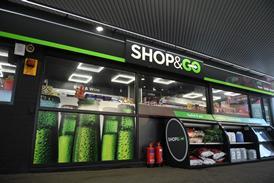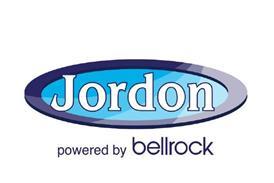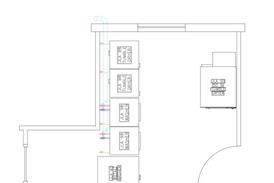Forget salads, soups and sushi - British consumers still choose a sandwich (chicken salad is their favourite) for their lunchtime nosh. Last year, according to Mintel, UK consumers spent around £4bn on sarnies, up from just £3.3bn in 2002, and the market is expected to grow further - to reach £5bn by 2012.
According to the British Sandwich Association (BSA), Subway is selling the most sandwiches - £300m-worth a year - followed by Tesco and Marks & Spencer.
Unfortunately the BSA says the biggest losers in the past year have been garage forecourts, down 10% in volume, and bakers. However there is obviously a market for the ’convenience’ sandwich as the BSA reports that symbol stores and c-stores have both done well in the past year.
When it comes to spend, it says £1.85 is now the average spent on a sandwich, however there is still a perception issue over pricing as most consumers think "it costs nothing" to make a sandwich at home.
Forecourt-cum-convenience stores can obviously tap into both sales areas - ready-made sandwiches and bread, spread and fillings - but the ready-made ones are probably where most sales and profit opportunities lie.
Vivianne Ihekweazu, senior market analyst at Mintel, has nothing but praise for the sandwich market: "It has turned itself around. Having successfully tapped into the trend for healthy eating, it is now clearly reaping the rewards. With the likes of superfood and wheat-free varieties now available, sandwiches increasingly appeal to the rising number of Brits looking for naturally good and wholesome food.
"There is also a greater variety of fillings to choose from, allowing Brits to be more adventurous and go for sandwiches such as Middle Eastern falafel or Oriental style chicken, a far cry from the traditional cheese and ham variety," she adds. That said, traditional fillings remain the UK’s favourites - see the box on the left.
However, the Mintel report states that consumers are becoming more ethically minded and are concerned with both the environment and with animal welfare. "Consumers are looking for high-quality free-range meat and eggs, as well as packaging that won’t harm the environment," says Ihekweazu.
One company that is committed to local sourcing is Ginsters, for both its pastries and its sandwiches. The company is rebranding its entire product portfolio to communicate its commitment to the highest quality, fresh ingredients and the importance of local sourcing. The words ’Ginsters of Cornwall’ will, from this month, be featured prominently across all packaging which has a new look in a bid to broaden its appeal to a wider audience.
The new logo features the Cornish flag and a clear geographical indicator to make it even easier for consumers to identify the range in store. The Real Honest Food message remains a key on-pack element.
Ginsters is currently enjoying a record market share of 8.2% of the total savoury pastry market and is also now the UK’s leading branded sandwich with a 28.8% share.
Its relaunch activity is supported by £6.5m spend including a press and outdoor campaign, which will be followed by TV advertising in the autumn.
Andy Valentine, head of brand marketing at Ginsters, comments: "We know that provenance and quality are key issues for consumers and thought it was time we began to shout about how our products reflect this. Local sourcing is something that, as a brand, we’ve done for a long time and we’re extremely proud of it."
Sandwiches however form just part of a lunch - typically consumers choose crisps and a drink to go with them. However, according to BSA data, 73% of sandwiches are purchased on their own. Retailers are obviously missing a trick here and probably need to work harder on cross-merchandising and point-of-sale messaging that reminds shoppers to pick up other items in-store.
Mintel reckons that to encourage more people to buy sandwiches, retailers should start to offer more combination lunches, with a small sandwich and mug of soup or side-salad meal deal.
== Quick and easy ==
"With two-thirds of workers now taking less than 30 minutes for lunch it has never been more important for forecourt retailers to provide a lunchtime offer that delivers quality products quickly and in a format that makes them fast and easy to eat," says Country Choice marketing controller, Stephen Clifford, who is also a fan of the sandwich. "While new products such as paninis have gained in popularity, research shows that when it comes to lunchtimes, the sandwich is still king, with 51% of the adults surveyed in a recent Mintel report preferring a sandwich over other options for their midweek lunch."
Hatton says consumers have become far more discerning of late and while some are still looking for value for money/cheap cassette sandwiches, a rapidly growing number are looking for other attributes such as health and freshness. "In order to satisfy these consumers, retailers need to cover all options if they are to maximise their sandwich trade. This means offering a wide variety of new and exciting fillings - often with reduced fat or salt content - in a range of premium-quality carriers, and all freshly prepared in-store under the watchful eye of the consumer.
He reports that sales of salads, and in particular fruit salads, continue to grow, as do sales of pizzas and the ’all day breakfast’ items which have enabled retailers to successfully straddle the periods between breakfast and lunch, and lunch and dinner.
Baguettes are the big thing for Total at the moment. Foodservice manager Ian Mackie explains: "We are currently offering fresh-filled baguettes at 85 sites and they are very, very popular. They’re a big eat so are most popular with men. Best sellers are tuna mayo followed by chicken, but we do refresh the range regularly, introducing more exotic lines like char sui pork."
The bread and fillings are provided by Country Choice and the baguettes are made up twice a day in prep rooms out the back of the stores.
Mackie says most people pick up a drink and crisps or chocolate with their baguettes. "We run a permanent meal deal on baguettes where consumers get a baguette, a packet of crisps and a bottle of Coke or Evian for £3.49. And to encourage our breakfast consumers to buy their lunch from us as well, we are currently running a four-week promotion where they can get a half price baguette when they buy a hot breakfast item.
"Our pricing is very competitive," he says, "Our top-price baguette is just £2.69." The baguettes have a 24-hour life and inevitably there is some wastage. "We run at about 15% wastage on baguettes but with foodservice you always get wastage."
Mindful that not everyone wants a baguette for their lunch, Mackie says Total is moving into subs and bagels. "We’ve got a healthy poppy seed bagel for the summer with a low-fat chicken, cucumber & yogurt filling - it’s delicious!"
== Feel the heat ==
Mackie says Total is currently looking at hot lunch solutions. Meanwhile Kepak Convenience Foods, the company behind the Rustlers brand, reckons lunchtime represents an opportunity for forecourts to generate incremental profits by promoting hot snacking products that can be cooked quickly in a microwave.
The company reports that demand for hot snacking products is already high at lunchtimes with £30m-worth, equating to 25% of the total market, purchased between 12 noon and 2pm.
Kepak, which boasts an 80% share of the hot snacking market, says having a microwave on site is the quickest and easiest way to generate incremental sales of these products.
"Although nine out of 10 motorists have access to a microwave at work or home, many want to enjoy a hot snack without it having to delay their journey," explains Aoife Kenny, convenience business unit controller at Kepak.
"And that’s where easy-to-prepare hot snacking products, which fill the hunger gap, come into their own." Kenny advises forecourts to stock the three top-selling lines: Rustlers flame grilled quarter pounder with cheese; the flame grilled chicken sandwich; and the BBQ rib, as these account for 85% of category sales.
But Kepak is also targeting the lunchtime market with its recently-launched Ugo’s Deli Café panini, which is being marketed as ’the hot alternative to lunchtime sandwiches’. Launched last September, the range is already worth £5m.
It comprises two products: chargrilled chicken with mozzarella cheese & pesto; and bacon, cheese & mustard mayo.
Meanwhile Ginsters reckons it has identified a gap in the market for a premium ready meals range that is quick to prepare but has the quality and nutritious food values that consumers are looking for.
Its solution is Ginsters Real Meals, described as "an everyday convenient hot meal solution to eat anywhere". They can be microwaved and ready to eat in just four minutes.
With a recommended retail price of £2.99, there are three varieties: beef & peppered dumplings; pasta bolognese; and chicken tikka & rice.
Ginsters’ Andy Valentine says: "Real Meals not only cater to a diverse range of usage occasions but also appeal to a wide cross-section of consumers from busy office workers needing a convenient lunch on the go, through to people on the move wanting a quick meal, to mums at home looking for a quick and easy mealtime alternative."
The range will benefit from Ginsters’ above-the-line brand campaign as well as bespoke point-of-sale support.
----
=== Top 10 Sandwich fillings ===
1. Chicken salad
2. Chicken & bacon
3. Bacon lettuce & tomato
4. Ploughmans
5. Mixed selection
6. Chicken
7. Prawn mayonnaise
8. Chicken & stuffing
9. Egg & cress
10. Tuna & sweetcorn
Source: British Sandwich Association
----
=== Lunchtime shoppers ===
* 5% of customers intended to buy something for lunch ’here today’ - 6% actually did.
Commentary: This indicates a little impulse in this category but surely this should be higher as people are tempted by the range of lunch items on display? Retailers need to ask whether the category is clearly signposted and is it visible from the door?
* 36% of those surveyed had visited a bakers in the past month and 18% had visited a sandwich shop
* 12% of customers had bought lunch items from ’this store’ once in the past seven days.
* 29% said there was enough choice of food-to-go items ’here today’
* Of all those shoppers who intended to buy crisps/snacks ’here today’, 10% failed to do so
* 2% intended to buy freshly made sandwiches/baguettes ’here today’
* 2% intended to buy chilled sandwiches/baguettes ’here today’
* 24% said they could see a food-to-go/snack offer outside the store
Commentary: Visibility is crucial to driving awareness of these products and tempting people into the store to try them.
Source: HIM’s Convenience Tracking Programme 2008: average figures from c-stores including forecourts
----
=== Case study: Welcome break - Newport Pagnell ===
Last summer, commercial refrigeration supplier Caravell was selected by Welcome Break to create a sandwich chiller in a retail outlet at one of its busiest service stations in the country, Newport Pagnell.
Welcome Break wanted to increase sales of sandwiches in the WH Smith part of the service station. Competition from the catering outlets on site meant sandwiches were not selling that well in the WH Smith retail store because it was not the natural choice for purchasing sandwiches. The shop needed a better display to attract shoppers.
Caravell came up with a bespoke island unit similar to those used in upmarket delicatessens. Four of its top-of-the-range CPD cabinets were arranged two in a line, then back to back, with a CPD 600 unit at each end to form the island. Wooden corners were added so WH Smith could sell ambient products, making the unit a one-stop snack stop. The delicatessen look and feel was further conveyed through the placing of baskets on each corner of the unit, to display fruit and other healthy snacks to reinforce the premium feel.
The results were outstanding. By December 2007, within just two and a half months of installing the new units, sales of sandwiches had increased by 40%.
Meanwhile a smaller unit has been trialled at the London Gateway petrol forecourt - which has also achieved its aim of increasing sandwich sales. A similar trial at Corley has also been undertaken, but results are yet to be analysed.























No comments yet